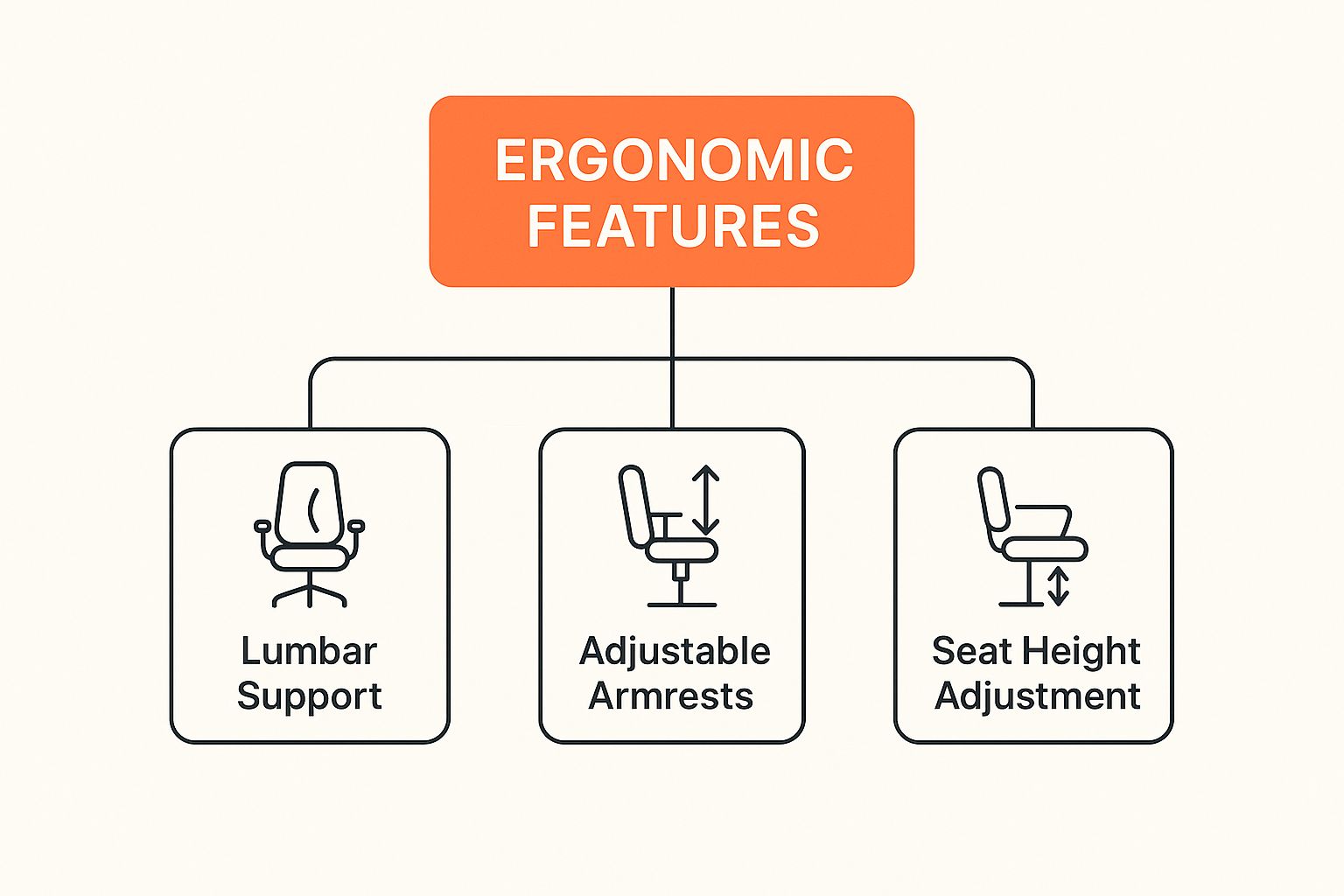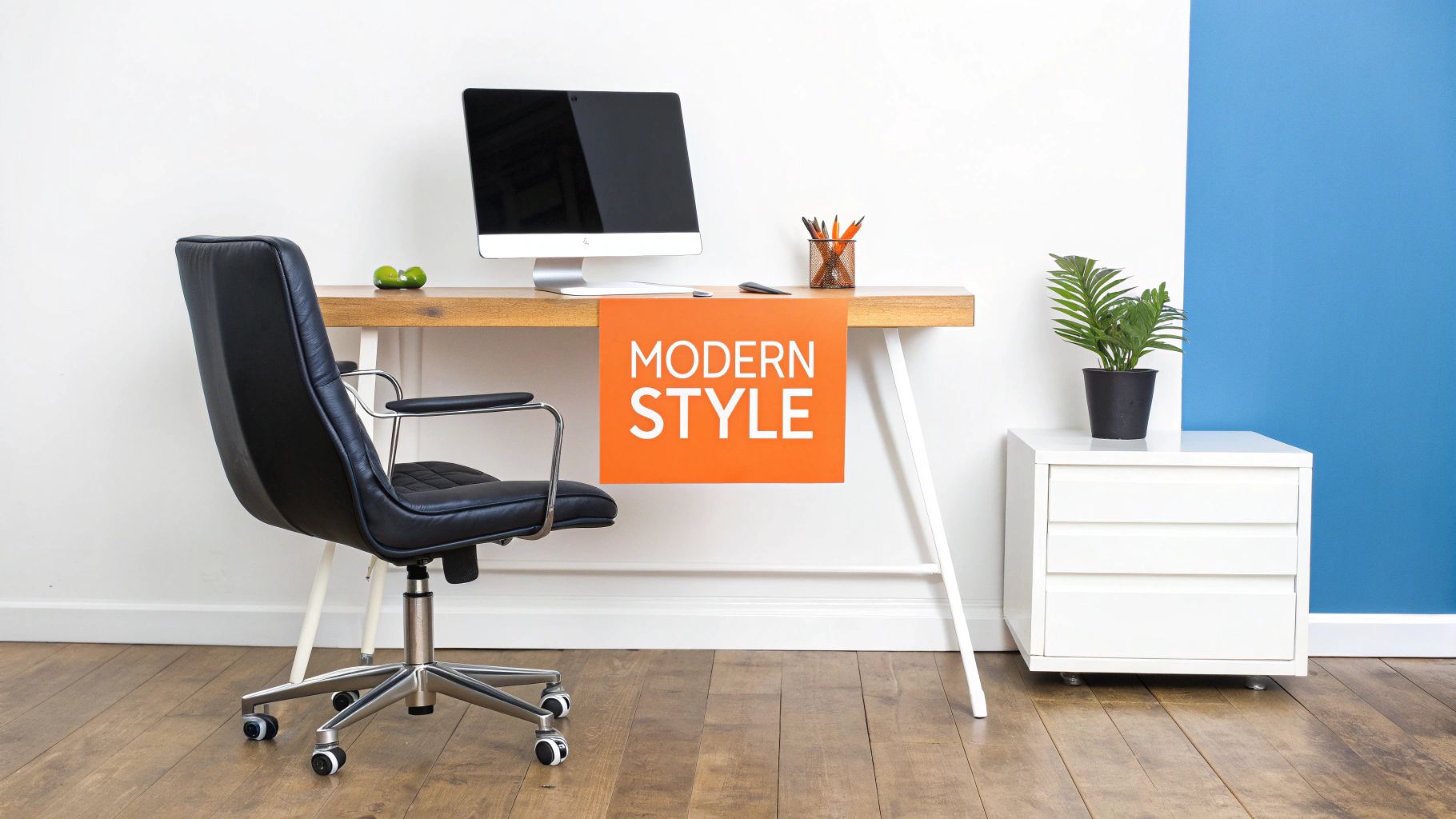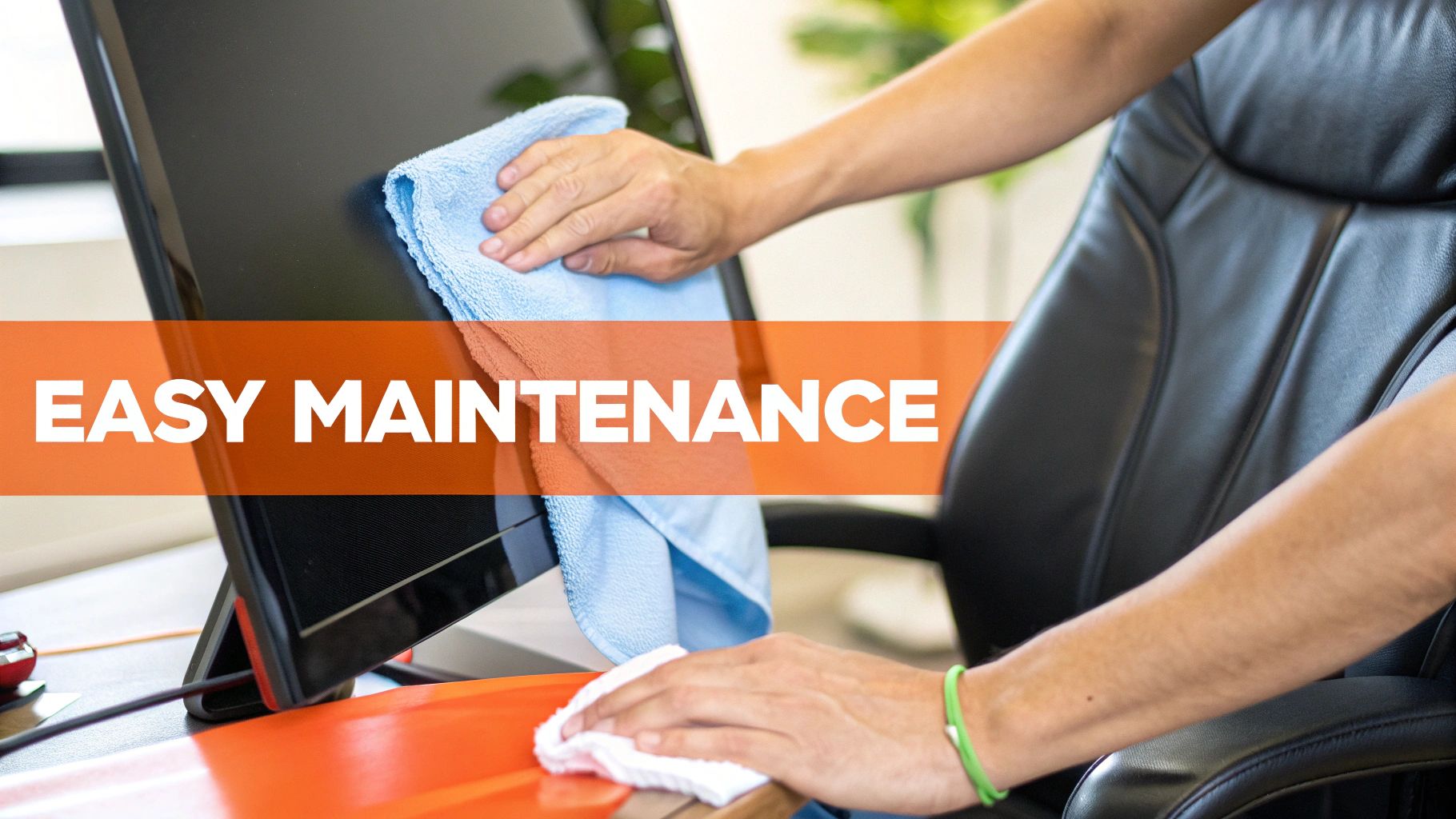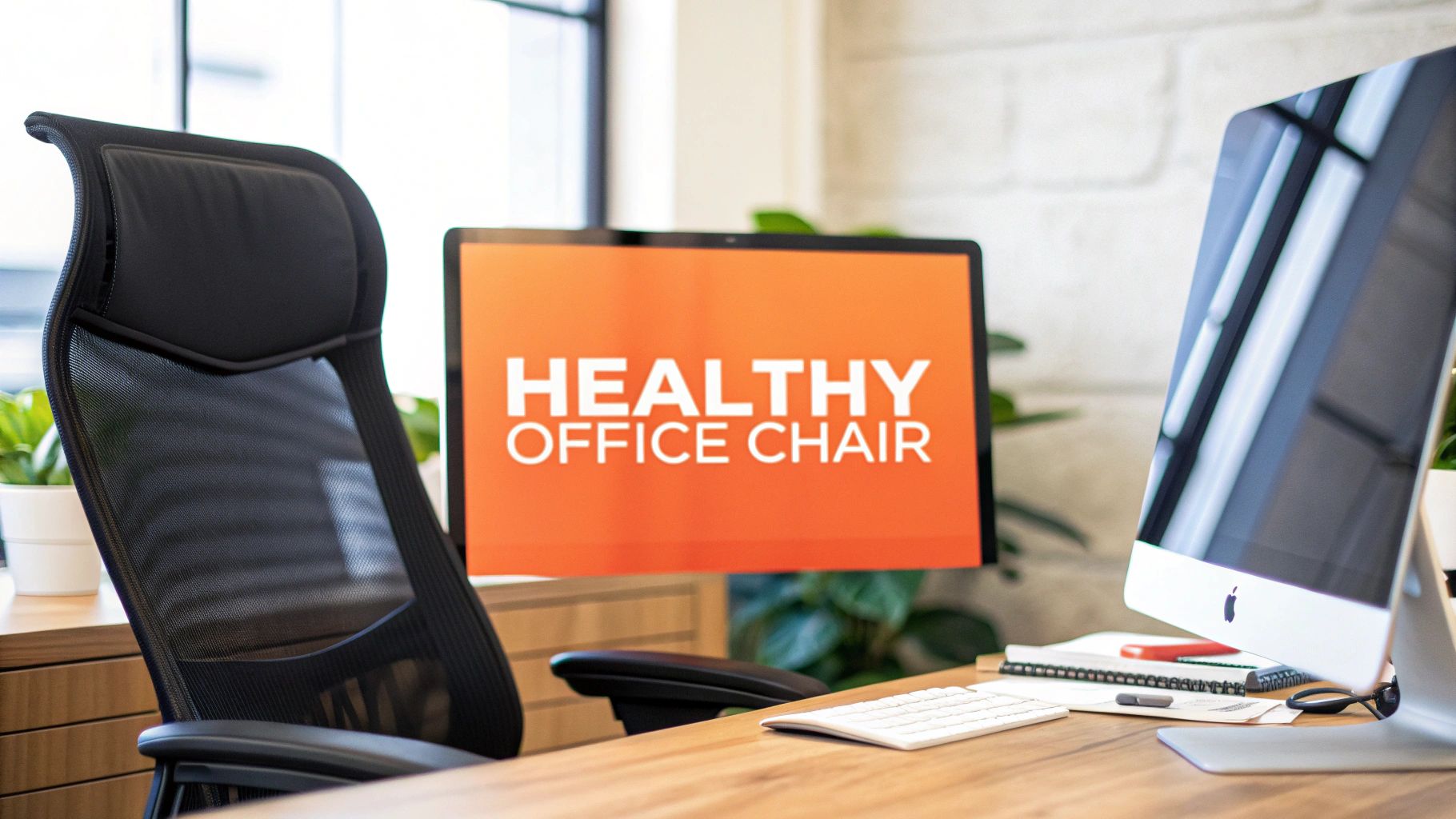Choosing the right computer chair for office work is about more than just finding a place to sit. It’s about choosing the most important tool you'll use every single day. Think of it as a direct investment in your health, focus, and productivity—one that prevents long-term strain and actually boosts your performance.
Why Your Office Chair Is Your Most Crucial Work Tool

Picture a professional chef. What's their most vital piece of kit? It’s not the oven or the fancy mixer; it’s their knife. It’s the one tool they have in their hand all day, and its quality directly affects their skill and efficiency. For anyone who spends hours at a desk, your office chair is your knife. It’s the foundational support for every task, meeting, and deadline you tackle.
Unfortunately, many workplaces have a long history of treating chairs like generic furniture. They opt for one-size-fits-all models that completely ignore individual needs. This oversight is the source of so many preventable problems, from that nagging ache in your lower back to persistent shoulder tension that kills your concentration. A bad chair forces your body into unnatural positions, and that leads directly to fatigue and distraction.
The Shift Towards Ergonomic Essentials
Thankfully, that old mindset is starting to change. Businesses are finally recognising the undeniable link between proper ergonomic support and employee wellbeing. This shift is easy to see in the numbers. The global office chairs market was recently valued at around USD 14.69 billion, with the demand overwhelmingly driven by features designed to minimise work-related musculoskeletal issues.
This guide is here to help you move past the idea that a good computer chair for office use is some kind of luxury. It's not. It's a necessity. A well-chosen chair isn't just about feeling comfortable; it's about creating an environment where you can do your best work, day in and day out. Just as a tidy desk helps you think clearly, a supportive chair provides the physical foundation for focus. For more on this, check out our tips on effective cable management solutions.
A great office chair doesn’t just prevent pain. It actively enhances your ability to focus and produce high-quality work by removing physical distractions and supporting a healthy posture.
In the sections ahead, we’ll break down what really makes a chair great. We'll explore the must-have ergonomic features, look at the tangible return on investment, and walk you through a step-by-step process for picking the perfect model for your body and work style. Whether you’re outfitting an entire office or just upgrading your home setup, you’ll walk away with the confidence to make an informed decision that will pay you back for years.
Understanding Essential Ergonomic Features
The word 'ergonomic' gets thrown around a lot these days, but what does it actually mean when we're talking about a good office chair? Put simply, an ergonomic chair is designed to fit you, not the other way around. It’s a bit like getting a suit custom-tailored; every adjustment is there to support your unique body shape, creating a perfect fit that feels natural and prevents aches and pains.
This personalised support comes from several key features working in harmony. When a chair lacks these, your body has to compensate, which leads to the all-too-common slouching, muscle tightness, and fatigue that plague so many office workers. A truly ergonomic chair is an active tool, one that constantly adapts to your movements and encourages healthy posture all day long.
The Foundation of Support Your Body Needs
At its core, ergonomics is all about maintaining the natural 'S' curve of your spine, even when you're sitting down. This is especially important for your lower back, or lumbar region. Without the right support, this gentle inward curve flattens out, putting a huge amount of pressure on your spinal discs. This is where adjustable features go from being a nice-to-have to an absolute necessity.

As you can see, features like lumbar support, adjustable armrests, and seat height aren't just extras—they are the fundamental pillars of proper ergonomic design.
To help you understand exactly what to look for in a quality office chair, let's break down the most important components and what they do for your body.
Each of these adjustments plays a critical role in creating a seating experience that actively supports your health, rather than working against it.
Breaking Down the Critical Adjustments
Getting to know what each lever and knob on your chair does is the key to unlocking its full health benefits. Every adjustment is designed to tackle a specific pressure point, helping to spread your weight evenly and keep your blood flowing. Let's look at the must-haves.
Adjustable Lumbar Support: This is arguably the most critical feature. It’s a mechanism—often a sliding pad or an inflatable cushion—that you can position perfectly into the small of your back. This targeted support stops you from slouching and can reduce the load on your spine by up to 40%, which is huge for preventing long-term back pain.
Seat Height Adjustment: Getting your seat height right is vital for healthy leg circulation. You want your feet flat on the floor with your knees bent at roughly a 90-degree angle. This position allows blood to flow freely without any restriction. A pneumatic gas lift makes finding this sweet spot quick and easy.
Seat Depth Adjustment: The ideal seat depth leaves a small gap—about two or three fingers' worth—between the front edge of the seat and the back of your knees. This is crucial for preventing the seat from cutting off circulation to your lower legs.
These three adjustments are the absolute bedrock of ergonomic support. If you want to dive deeper, you can explore more about what defines an ergonomic chair in our detailed guide.
Fine-Tuning for Personalised Comfort
Beyond the basics, a few other features allow you to fine-tune the fit, reducing strain on your neck, shoulders, and arms. A high-quality computer chair for office work will always include these next-level customisations.
An ergonomic chair isn't just about feeling comfortable while you sit still. It's about creating a dynamic environment that encourages small movements, which is essential for preventing the stiffness and muscle fatigue that comes from being in one position for too long.
Think about how these extra features contribute to your overall support:
Adjustable Armrests: Armrests that can move up and down (and ideally in and out) are a game-changer. You should set them at a height where your shoulders feel completely relaxed and your forearms are parallel to your desk. This simple tweak takes a massive amount of strain off your neck and shoulders.
Tilt Mechanism with Tension Control: This lets you lean back comfortably without losing support. The tension control can be dialled up or down based on your body weight, so you can rock back and forth smoothly without feeling like you're about to tip over. This movement is fantastic for shifting your posture and relieving pressure on your spine throughout the day.
Swivel Base and Quality Castors: Being able to turn and roll without straining is a core part of an ergonomic setup. A stable, five-point base with smooth castors means you can reach for things around your desk without twisting your back into an awkward position.
The Real Return on a Quality Office Chair

When you invest in a genuinely good computer chair for office work, you're getting something that pays you back long after the initial purchase. Sure, the immediate comfort is great, but the real value shows up over weeks, months, and years. Think of it less as an expense and more as a smart investment in your health and your work.
For you as an individual, the payoff is obvious. A properly supportive chair means you're not constantly distracted by aches and pains. It helps you stay focused and energetic right through the day, fighting off that classic afternoon slump. By taking care of your posture, it frees you up to concentrate on the tricky tasks without your body getting in the way.
This isn't just a hunch; the market shows a clear shift in priorities. Australia's office furniture market is already valued at around USD 1.8 billion, and it's tipped to grow to USD 2.5 billion by 2033. A huge driver behind this is the growing realisation that good ergonomics is directly linked to employee health and output.
The Business Case for Better Seating
From a business perspective, the return on investment (ROI) is even more tangible. When your team is comfortable and pain-free, productivity naturally goes up. With fewer physical distractions, people can dive deeper into their work, leading to better results and greater efficiency all around.
It also hits the bottom line by cutting down on absenteeism. Back and neck pain are some of the biggest culprits for sick days in an office setting. Providing seating that actually supports your staff can slash these health-related absences, keeping your team on deck and productive.
A quality office chair sends a powerful message without saying a word. It tells your team, "We care about your health," and that's the foundation of a great company culture.
This investment in your people builds real loyalty and job satisfaction. In a tight job market, it’s often the little things that count. Showing you’re genuinely committed to your team's wellbeing can be a massive advantage when it comes to attracting and keeping great talent.
Long-Term Gains in Health and Focus
The long-term health benefits of a proper ergonomic chair are huge. Using one consistently helps stop chronic pain from developing after years of poor posture. It's about being proactive with workplace wellness, not just reactive.
Think about these long-term wins for yourself:
- Improved Posture: A good chair actually encourages your body to hold a healthy spinal alignment, and those benefits follow you even when you're away from your desk.
- Sustained Energy: By taking the physical strain off your body, the chair helps you hang onto your energy, so you feel more alert and less worn out by the end of the day.
- Enhanced Concentration: When you're not constantly shifting around trying to get comfortable, you can get into a state of deep, focused work much more easily.
At the end of the day, picking the right chair is about understanding that your physical comfort and mental performance are two sides of the same coin. If you’re searching for options that deliver on this promise, checking out a list of the 12 best ergonomic office chairs in Australia is a great place to start. A quality chair isn't just furniture; it's a tool for better work and a healthier life.
How to Find Your Perfect Computer Chair
Now that you've got a handle on the principles of ergonomics, it's time for the fun part: finding the perfect computer chair for office use. The secret isn't about tracking down one single "best" chair on the market. It's about finding the best chair for you. This all starts with a little self-assessment to figure out your unique needs.
Think of it like getting fitted for a new pair of running shoes. A serious runner wouldn’t just grab the first pair they see. They’d think about their foot shape, their running style, and the kind of distances they're tackling. Your approach to choosing a chair should be just as personal and deliberate to make sure you get the right support where it counts.
Start with a Personal Assessment
Before you even start browsing, take a moment to understand what your body actually needs from a chair day-to-day. A chair that’s a dream for a tall person working four hours a day might be a total nightmare for a shorter person putting in a nine-hour shift.
Just answer these three simple questions to build your personal profile:
How many hours will you sit each day? If you're going to be sitting for more than four hours, you absolutely need a chair built for proper commercial use. That means high-density foam that won’t flatten out and adjustment mechanisms that are built to last. For shorter stints, you might have a bit more flexibility.
What is your body type? Think about your height and weight. Most standard chairs are designed for a pretty average build. If you're taller, shorter, or heavier than average, you’ll want to look for models that are specifically designed to support your frame, like chairs with extended gas lifts or wider seats.
Do you have any pre-existing conditions? If you're dealing with lower back pain, sciatica, or even stiff shoulders, certain features become non-negotiable. Things like adjustable lumbar support or 4D armrests can make a world of difference. Be honest about your pain points so you can prioritise the features that will actually provide relief.
This quick assessment acts as a powerful filter, helping you cut through the noise and narrow down the huge number of options to a manageable shortlist of real contenders.
The Art of the 'Test Drive'
Whether you’re shopping online or walking into a showroom, you have to "test drive" a chair to know if it's the one. If you find yourself in a store like Officeworks, take your time. Don't just plop down for 30 seconds and call it a day.
Spend at least five, maybe even ten minutes in the chair. Try to mimic what you do at your desk—type on your phone, lean forward to concentrate, recline back to think. The goal is to see how the chair supports you while you’re moving, not just when you’re sitting perfectly still like a statue.
When you're testing a chair, be really mindful of pressure points. If you feel any specific areas of discomfort—maybe under your thighs, in your lower back, or between your shoulder blades—that's a red flag. It’s a clear sign the chair isn't a good match for your body shape.
While you're sitting, run through this quick mental checklist:
- Foot Placement: Can you adjust the height so your feet rest flat on the floor with your knees at a comfortable 90-degree angle? Your feet should never be left dangling.
- Seat Depth: Is there a small gap, about two to three fingers wide, between the front edge of the seat and the back of your knees? This is crucial to prevent the seat from cutting off your circulation.
- Lumbar Fit: Does the curve of the lumbar support fit snugly into the small of your back? It should feel supportive and natural, not like it's aggressively pushing you forward.
- Armrest Position: Can you adjust the armrests so your shoulders are relaxed and your forearms are parallel to the floor? They’re there to support your arms, not make you hunch up.
Of course, a great chair is only one piece of the puzzle. Our ergonomic workstation setup checklist can walk you through arranging your entire desk, monitor, and chair for a healthier workday.
Demystifying Quality Certifications
While you're comparing chairs, especially here in Australia, you'll almost certainly come across the acronym AFRDI. This stands for the Australasian Furnishing Research and Development Institute, an independent organisation that rigorously tests furniture for safety, durability, and stability.
Basically, an AFRDI certification is a seal of approval. It’s your guarantee that the computer chair for office use has been built to a demanding commercial standard.
- AFRDI Level 6 Certified: This is the gold standard for heavy-duty, around-the-clock commercial use. These chairs have been tested to withstand intense, prolonged sitting and are engineered to last for years. A Pago chair, for instance, is a great example of a product built to this exacting standard and is available through their website or retailers like Officeworks.
- AFRDI Level 4 Certified: This certification is for general domestic use. It indicates a good quality chair, but it hasn’t been put through the wringer for the demands of a full-time, 40-hour-a-week office environment.
Choosing a chair with an AFRDI Level 6 certification gives you peace of mind. You know you're investing in a durable, safe, and reliable product that won't let you down after a year or two. It's the clearest sign you’re buying a professional tool, not just another piece of furniture.
Why Pago Is a Smart Choice for Australian Offices
Trying to find the right computer chair for your office can feel like a huge task, especially with so many options on the market. But when you start to connect the ergonomic principles we’ve covered with actual product features, one name keeps popping up: Pago International. Their chairs aren't just about looking good; they're built from the inside out to provide real, lasting support.
You can see this commitment in their core design. Many Pago chairs come with a sturdy 3-lever mechanism, giving you pinpoint control over seat height, seat tilt, and the backrest angle. This isn't just a basic up-and-down adjustment; it allows you to fine-tune your posture in a way that most off-the-shelf chairs simply can't.
Built for Durability and Personalised Comfort
Pago chairs are designed for the real world of the Australian workplace. A great example is the ratchet back adjustment system, which lets you change the backrest height in seconds. This means your lower back support is always exactly where it needs to be.
Combine that with seats made from high-density moulded foam, and you get support that’s firm but comfortable. More importantly, it won't flatten or sag, even after years of daily use.
What really sets Pago apart is their focus on certified quality. These chairs aren’t just designed to feel good for a few weeks—they’re engineered to meet strict industry standards for long-term commercial use.
This is backed by their AFRDI Level 6 certification. Think of it as a guarantee that the chair has been put through its paces, passing tough tests for durability, stability, and safety. It’s peace of mind, knowing you’re investing in something built to last.
Unmatched Customisation and Market Leadership
Beyond solid engineering, Pago offers a level of customisation that’s hard to find. We all know how important branding is, and being able to choose from a huge range of fabrics and colours means businesses can match their furniture to their corporate identity. Ergonomics and aesthetics can finally go hand-in-hand.
The Australian commercial office furniture market is valued at around AUD 3.5 billion, which tells you there's a serious demand for high-quality, flexible seating solutions. As businesses continue to focus on employee wellbeing and hybrid work, brands that deliver on both comfort and quality are pulling ahead. You can read more about the Australian commercial office furniture market to see the trends.
Choosing the right chair is a big part of workplace safety. If you want to dive deeper into this, have a look at our ergonomic risk assessment template for workplace safety. Whether you’re setting up a new office or just upgrading your chair at home, Pago offers a solution that’s reliable, customisable, and genuinely ergonomic.
Ready to feel the difference? You can explore the full range of customisable options on the Pago International website or find a selection of popular models available for purchase directly from Officeworks.
Your Office Chair Questions, Answered

Even with all the right information, a few questions always seem to pop up when it's time to choose a new chair. Getting straight answers to these common queries is often the final piece of the puzzle, helping you make a decision you feel truly confident about.
Think of this section as a final check-in before you buy. We'll tackle the most frequently asked questions to clear up any last-minute doubts and make sure you're ready to invest in a computer chair for office work that will look after you for years to come.
How Long Should a Quality Office Chair Last?
A good, commercial-grade office chair is built to last. You should expect to get a solid seven to ten years of service out of it, and sometimes even more if you look after it. Its lifespan really comes down to the quality of the parts you can't always see—the base, castors, gas lift, and the foam inside the upholstery.
In Australia, the best seal of approval you can look for is an AFRDI (Australasian Furnishing Research and Development Institute) certification. This means the chair has been put through its paces with serious testing for durability and safety, so you know it’s up to the task. A little bit of simple care, like tightening the odd screw and cleaning the fabric, will also go a long way in extending its life.
What Is the Single Most Important Ergonomic Feature?
If I had to pick just one, it would be adjustable lumbar support. No question. Your lower back has a natural inward curve, and without proper support, we all inevitably start to slouch. This puts a huge amount of strain on the spine.
A truly ergonomic chair must let you adjust the height of the lumbar support so you can nestle it perfectly into the small of your back. Without that targeted support, the daily grind of sitting for hours often leads to nagging lower back pain and poor posture that's hard to break.
A chair without adjustable lumbar support is like a pair of shoes without arch support. It might feel fine for a little while, but over time, it fails to provide the foundational stability your body needs, leading to discomfort and strain.
Is a Mesh Back Better Than a Padded Back?
Honestly, one isn't better than the other; it’s all about what works for you and your workspace. Both mesh and padded backs have their own clear advantages, so it really depends on what you prioritise.
Mesh Backs: The big win here is breathability. The open weave lets air flow freely, which is a lifesaver in warmer offices or climates. Mesh is also great at moulding to the shape of your back, giving you support that moves with you.
Padded Backs: These offer a softer, more cushioned feel that many people simply find more comfortable. A high-quality padded computer chair for office use will have high-density moulded foam that won't flatten out after a year, giving you firm, consistent support day in, day out.
At the end of the day, it's a trade-off. If staying cool is your top priority and you like a chair that flexes, go for mesh. If you prefer a plusher, more cushioned feel, a well-made padded back is the way to go.
How Do I Correctly Set Up My New Ergonomic Chair?
Getting the setup right is non-negotiable if you want to reap the benefits of your new chair. It’s not enough to just take it out of the box; you need to spend a few minutes dialling in the adjustments to fit your body and your desk.
Just follow these simple steps to get your personalised fit:
- Set Your Height: Start by adjusting the seat height so your feet are flat on the floor. Your knees should be at a 90-degree angle, with your thighs pretty much parallel to the ground.
- Adjust the Depth: Now, slide the seat forward or back. You want a gap of about two to three fingers' width between the edge of the seat and the back of your knees. This is crucial for healthy blood flow.
- Position Lumbar Support: Move the lumbar support up or down until it sits perfectly in the curve of your lower back. It should feel snug and supportive, not like it’s pushing you forward.
- Fine-Tune Armrests: Lastly, adjust the armrests so your shoulders can completely relax. Your forearms should be parallel to your desk, with your elbows at a comfortable 90 to 110-degree angle.
Take your time with this! Getting these settings right from the start will make an enormous difference to your comfort and focus throughout the day.
Ready to find a chair that ticks all the boxes for durability, comfort, and certified ergonomic support? Explore the full customisable range from Pago International.
Discover your perfect fit on the Pago website or see a curated selection at your local Officeworks.


